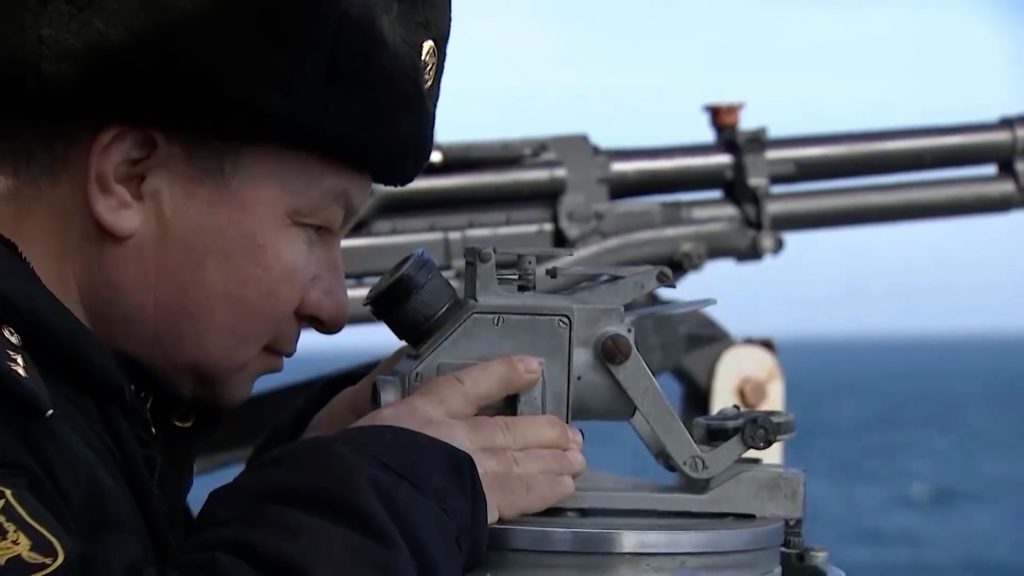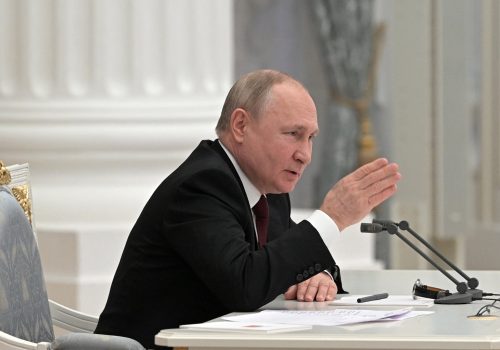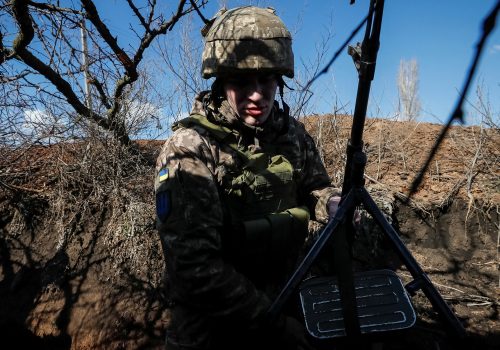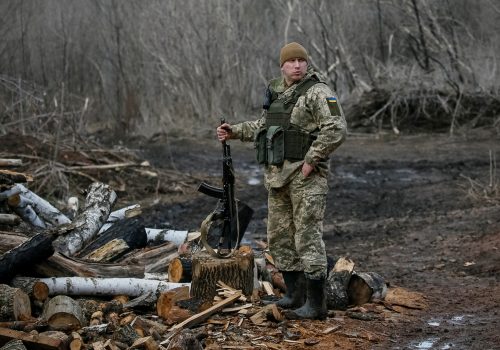In light of the ongoing Russia crisis, the Scowcroft Center’s Forward Defense (FD) practice will share weekly assessments of the latest force developments surrounding Ukraine, leveraging the expert perspectives of our senior military fellows. The opinions, conclusions, and recommendations expressed or implied here are solely those of the authors and do not represent the views of the Department of Defense or any other US government agency.
The bottom line
Russia has completed preparations for a large-scale offensive operation, with two separatist republics in the Donbas region now formally requesting Vladimir Putin’s military intervention, leading us to believe that the Kremlin could execute a further invasion of Ukraine beyond the separatist line of control in Donbas with virtually no unambiguous warning. Russia’s joint exercise with Belarus has focused on a combined arms offensive, including establishing air superiority and providing air support to a large, mechanized force. Out at sea, we predict that Russia’s navy may seek to control the waterways in the Sea of Azov—with the possible seizure of the Port of Mariupol—while increasing pressure on any NATO units in the Black Sea or Mediterranean Sea.
Russian force movements
Air and air defense: The Russian Air Force (RuAF) has the aircraft in place to support a major offensive. In the event of a further, large-scale invasion, we are convinced that RuAF could quickly establish air superiority over Ukraine and provide close air support (CAS) to ground forces, as well as interdict Ukrainian reinforcements and resupply.
- Russia’s build-up of air forces in Belarus and on its border with Ukraine has been overwhelmingly focused on ground-attack aircraft and helicopters. Commercial satellite imagery confirmed 32 Su-25 Frogfoot aircraft deployed to Luninets Air Base in Belarus, 10 Su-34 Fullback aircraft to Primorsko-Akhtarsk Airfield on the Sea of Azov, at least 50 helicopters at Lida Air Base in Belarus, more than 60 helicopters on the Crimean Peninsula, and dozens of helicopters across the Bolgorod Oblast.
- Additionally, the use of distinctive markings on mechanized vehicles, such as a large “Z” painted on the sides of such vehicles, is likely intended to minimize friendly fire incidents both from the ground and the air, indicating to us that CAS will be a primary mission of the RuAF in the event of a large-scale offensive.
- These deployments, and the Russian and Belarusian Ministry of Defense press releases from the Union Courage ‘22 (Allied Resolve ‘22) exercise, demonstrate how the Russian Air Force is likely to employ its combat aircraft as support to a ground offensive in the event of a large-scale invasion. We believe Russia may use attack helicopters to conduct much of the CAS, while attack fighters such as the Su-25 and Su-34 (both analogous to the US Air Force’s A-10 Warthog) will be used to interdict Ukrainian reinforcements and supply convoys. Targets will be identified by Orlan-10 unmanned aerial vehicles and passed to the ground-attack platforms for destruction. Long-range Russian surface-to-air missile systems such as the S-400 and advanced fighters such as the Su-35S and Su-30SM Flanker variants (analogous to the USAF F-15C air superiority and F-15E multi-role fighters, respectively) will quickly dispatch Ukrainian combat aircraft, which we assess will allow Russia to establish air superiority within 48-72 hours and thus giving attack aircraft and helicopters the freedom of maneuver to support the mechanized ground offensive.
Navy: In recent Russian naval exercises across its four fleets, we saw a focus on anti-submarine warfare, surveillance, joint air and air-defense operations, and surface warfare. These exercises likely exhibit how the Russian navy would operate and hold NATO ships at risk if ordered.
- Black Sea: With the apparent Russian annexation of the Donbas region, Russia may look to seize the Port of Mariupol if it expands its perimeter beyond the separatist line of control. Mariupol is a significant commercial seaport in the Sea of Azov and controls much of the region’s grain exports and bulk shipments. Over the past few weeks, much has been made of Russian amphibious forces sailing into the Black Sea. Notably, Russia does not train to opposed amphibious landings, which are extremely costly both in blood and treasure. However, watch for an amphibious demonstration or resupply into Mariupol after Russia takes control as a supporting show of force. Subsequently, we anticipate that Russia could use such actions to signal the possibility for future amphibious landings elsewhere in the Black Sea, although such amphibious landings are unlikely unless they occur in Russia-controlled areas.
- Mediterranean Sea: On February 15, at the start of last week’s naval drills, we watched as Russian Minister of Defense Sergei Shoigu observed naval maneuvers in the Mediterranean. The exercises were supported by long-range aircraft Tu-22M3 bombers and MiG-31 fighters. The bombers were reportedly equipped with Kinzhal missiles—a hypersonic anti-ship missile capable of Mach 10 (7,600 miles per hour) with a maximum range of 1,200 miles—and drills focused on anti-submarine and anti-surface warfare.
Nuclear-capable forces: Meanwhile, Russia continues to use its nuclear forces to signal to the United States and NATO that further involvement in the Ukraine crisis brings the risk of nuclear conflict. After Russia illegally annexed Crimea in 2014, Putin made threats to defend the peninsula using Russia’s nuclear forces—could the same be in the offing for occupied Luhansk and Donetsk? That seems unlikely to us for now but could be a consequence of an eventual annexation.
- Russia exercises its nuclear arsenal—the world’s largest—on an annual basis. The exercises were held earlier than usual this year, just days before Russia’s move on Monday to recognize the separatist-occupied Ukrainian regions of Luhansk and Donetsk.
- Putin jointly oversaw portions of the exercises with Belarusian President Alyaksandr Lukashenka. This takes on additional significance given Belarus’s recent plan to revise its constitution to allow it to host Russian nuclear weapons.
- The exercises included tests of relatively new Russian nuclear-capable hypersonic weapons, including the Kinzhal air-launched ballistic missile and the Zircon anti-ship cruise missile. Like many Russian weapons with ranges of a few hundred to a few thousand miles, these are dual-capable (i.e., can be armed with conventional high explosive or nuclear warheads). Scholars and analysts debate the extent to which these kinds of weapons are destabilizing.
- While there were a few newer weapons tested over the weekend, the bulk of Russia’s nuclear forces have already been modernized, the result of a process that began in earnest around 2008.
Russian Activity in the Donbas: On February 21, Putin recognized the Donetsk People’s Republic and the Luhansk People’s Republic in the Donbas region, pledging to send “peacekeeping” forces in to mediate the fighting that has been ongoing since 2014. This will likely nationalize the irregular forces under the Russian Federation’s flag and pave the way for Russian troop reinforcements. If Russia pushes past the current line of control, we believe that Ukraine would likely resist, and Russia could then use as a pretext to escalate the fighting. Russia could also leverage misinformation about ceasefire violations to escalate attacks.
US, allied, and partner deployments
US Deployments: On February 16, the US Air Force deployed fifth generation F-35A Lightning II aircraft from Hill Air Force Base in Utah to Spangdahlem Air Base in Germany. According to General Jeff Harrigian, Commander of US Air Forces in Europe, the deployment of these jets is designed to bolster NATO forces during this period of heightened tensions with Russia. On February 22, US Secretary of Defense Lloyd Austin ordered at least eight of those F-35s to NATO’s eastern flank. In conjunction with the deployment of B-52s to England and F-15Es from the continental United States to Estonia, and the forward deployment of F-15Cs and F-16s to Poland and Romania, respectively, the US Air Force has significantly enhanced both the capability and capacity of its forces in Europe. Though unlikely to deter a large-scale Russian invasion of Ukraine, we assess the force now deployed in Europe will likely prevent Russia from expanding the conflict beyond Ukraine and can act as a force to blunt Russian aggression against NATO were Russia to attack any NATO country.
Allied and Partner Deployments: We expect that NATO will expedite actions to activate the NATO Response Force—a high-readiness force with land, air, sea, and special-forces units capable of being deployed quickly on operations—to improve defensive posture in the Baltic states.
FD’s conclusion
We assess Russia has essentially completed its build-up of forces in Belarus and on its border with Ukraine. Reporting indicates that large numbers of Russian forces and equipment are flowing into the separatist-controlled portions of the Donbas region, indicating that the Kremlin may be preparing to extend its control into more, if not all, of the Donbas. Russia could initiate a further, large-scale invasion of Ukraine, or cross to the Ukrainian side of the line of control in the Donbas region, with essentially no notice should they be ordered. Check out our military assessment map here.
Meet the FD team
Today’s briefing is brought to you by senior US Army fellow COL Benjamin Johnson, senior US Navy fellow CDR Daniel Vardiman, senior US Air Force fellow Lt Col Tyson Wetzel, senior US Marine Corps fellow Col J.B. Barranco, and FD assistant director Mark J. Massa. The Scowcroft Center Military Fellows Program, housed by the Forward Defense practice, hosts military fellows from participating branches of the US military and the armed forces of US allies and partners each year as part of a twelve-month fellowship program.
Further reading
Tue, Feb 22, 2022
Russian Hybrid Threats Report: Despite debunking of false flags, Putin recognizes breakaway republics
New Atlanticist By
The Council's open-source researchers break down how the Kremlin is seeking to justify incursions in Ukraine, and where the troops are moving.
Thu, Feb 24, 2022
LIVE: Russia-Ukraine peace talks, Putin’s nuclear threat, and Germany’s big military bet
New Atlanticist By
As Russia further escalates its military intervention in Ukraine, check back here for the latest insights, analysis, and reporting from the Atlantic Council's experts as events unfold.
Mon, Feb 21, 2022
Russia just ordered troops into Ukraine again. What happens next?
Experts react By
As the fast-moving situation on the ground develops, our experts weigh in on what this moment means for a world that could soon be forever altered.
Image: Image grab from footage released by the Russian defense ministry on Friday Feb 18, 2022 shows naval warships from the Russian Black Sea fleet conducting combat exercises performing artillery firing in the Black Sea on mock-up targets. Photo by EYEPRESS via Reuters Connect.



